В Android 15 представлены замечательные функции и API для разработчиков. В следующих разделах кратко описаны эти функции, чтобы помочь вам начать работу с соответствующими API.
Подробный список добавленных, измененных и удаленных API см. в отчете о различиях в API . Подробнее о добавленных API см. в справочнике по API Android . Для Android 15 найдите API, добавленные на уровне API 35. Чтобы узнать об областях, где изменения платформы могут повлиять на ваши приложения, ознакомьтесь с изменениями в поведении приложений, ориентированных на Android 15 , и для всех приложений .
Камера и медиа
Android 15 включает в себя множество функций, которые улучшают работу камеры и мультимедиа, а также предоставляют доступ к инструментам и оборудованию, помогающим создателям контента воплощать свои идеи в жизнь на Android.
Дополнительную информацию о новейших функциях и решениях для разработчиков в области мультимедиа и камер Android можно найти в докладе «Создание современных возможностей мультимедиа и камер Android» на конференции Google I/O.
Усиление при слабом освещении
В Android 15 представлен Low Light Boost — режим автоматической экспозиции, доступный как для Камеры 2 , так и для расширения камеры для ночного режима . Low Light Boost регулирует экспозицию потока предварительного просмотра в условиях низкой освещенности. Это отличается от того, как расширение камеры для ночного режима создает неподвижные изображения, поскольку ночной режим объединяет серию фотографий для создания единого улучшенного изображения. Хотя ночной режим очень хорошо работает для создания неподвижного изображения, он не может создавать непрерывный поток кадров, а режим Low Light Boost может. Таким образом, Low Light Boost обеспечивает такие возможности камеры, как:
- Предоставление улучшенного предварительного просмотра изображения, чтобы пользователи могли лучше кадрировать свои снимки при слабом освещении.
- Сканирование QR-кодов при слабом освещении
Если вы включите усиление при слабом освещении, оно автоматически включается при низком уровне освещенности и выключается, когда света становится больше.
Приложения могут записывать поток предварительного просмотра в условиях низкой освещенности, чтобы сохранить более яркое видео.
Для получения дополнительной информации см. «Усиление при слабом освещении» .
Управление камерой в приложении
В Android 15 добавлено расширение для большего контроля над оборудованием камеры и ее алгоритмами на поддерживаемых устройствах:
- Расширенные настройки мощности вспышки позволяют точно контролировать интенсивность вспышки как в режиме
SINGLE, так и в режимеTORCHпри съемке изображений.
Управление динамическим диапазоном HDR
Android 15 выбирает запас HDR, соответствующий возможностям основного устройства и разрядности панели. Для страниц с большим количеством контента SDR, таких как приложение для обмена сообщениями, отображающее одну миниатюру HDR, такое поведение может в конечном итоге отрицательно повлиять на воспринимаемую яркость контента SDR. Android 15 позволяет управлять запасом HDR с помощью setDesiredHdrHeadroom чтобы обеспечить баланс между SDR и HDR-контентом.
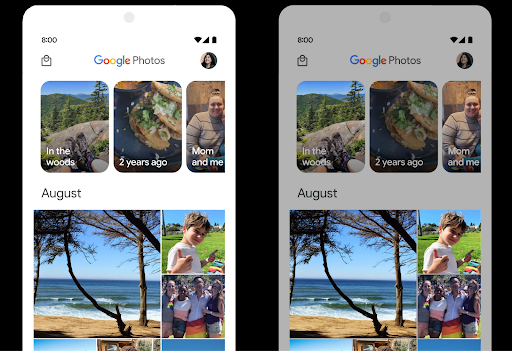
Регулировка громкости
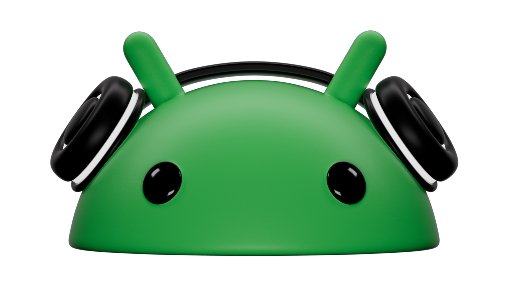
В Android 15 реализована поддержка стандарта громкости CTA-2075, который поможет вам избежать несоответствия громкости звука и гарантировать, что пользователям не придется постоянно регулировать громкость при переключении между контентом. Система использует известные характеристики устройств вывода (наушников и динамика), а также метаданные громкости, доступные в аудиоконтенте AAC, для интеллектуальной регулировки громкости звука и уровней сжатия динамического диапазона.
Чтобы включить эту функцию, вам необходимо убедиться, что метаданные громкости доступны в вашем контенте AAC, и включить функцию платформы в вашем приложении. Для этого вы создаете экземпляр объекта LoudnessCodecController , вызывая его фабричный метод create с идентификатором аудиосеанса из связанного AudioTrack ; это автоматически начнет применять аудиообновления. Вы можете передать OnLoudnessCodecUpdateListener для изменения или фильтрации параметров громкости перед их применением в MediaCodec .
// Media contains metadata of type MPEG_4 OR MPEG_D
val mediaCodec = …
val audioTrack = AudioTrack.Builder()
.setSessionId(sessionId)
.build()
...
// Create new loudness controller that applies the parameters to the MediaCodec
try {
val lcController = LoudnessCodecController.create(mSessionId)
// Starts applying audio updates for each added MediaCodec
}
AndroidX media3 ExoPlayer также будет обновлен для использования API-интерфейсов LoudnessCodecController для плавной интеграции приложений.
Виртуальные устройства MIDI 2.0
В Android 13 добавлена поддержка подключения к устройствам MIDI 2.0 с помощью USB , которые обмениваются данными с помощью универсальных пакетов MIDI (UMP). Android 15 расширяет поддержку UMP на виртуальные MIDI-приложения , позволяя приложениям композиции управлять приложениями синтезатора как виртуальным устройством MIDI 2.0 так же, как если бы они работали с устройством USB MIDI 2.0.
Более эффективное программное декодирование AV1

dav1d, the popular AV1 software decoder from VideoLAN is available for Android devices that don't support AV1 decode in hardware. dav1d is up to 3x more performant than the legacy AV1 software decoder, enabling HD AV1 playback for more users, including some low and mid tier devices.
Your app needs to opt-in to using dav1d by invoking it by name
"c2.android.av1-dav1d.decoder". dav1d will be made the default AV1 software
decoder in a subsequent update. This support is standardized and backported to
Android 11 devices that receive Google Play system updates.
Производительность и инструменты разработчика
Хотя большая часть нашей работы по повышению вашей производительности сосредоточена вокруг таких инструментов, как Android Studio , Jetpack Compose и библиотеки Android Jetpack , мы всегда ищем в платформе способы, которые помогут вам легче реализовать ваше видение.
Обновления OpenJDK 17
Android 15 continues the work of refreshing Android's core libraries to align with the features in the latest OpenJDK LTS releases.
The following key features and improvements are included:
- Quality-of-life improvements around NIO buffers
- Streams
- Additional
mathandstrictmathmethods utilpackage updates including sequencedcollection,map, andsetByteBuffersupport inDeflater- Security updates such as
X500PrivateCredentialand security key updates
These APIs are updated on over a billion devices running Android 12 (API level 31) and higher through Google Play System updates, so you can target the latest programming features.
Улучшения PDF-файлов
Android 15 includes substantial improvements to the PdfRenderer
APIs. Apps can incorporate advanced features such as rendering
password-protected files, annotations, form editing,
searching, and selection with copy. Linearized PDF
optimizations are supported to speed local PDF viewing and reduce resource use.
The Jetpack PDF library uses these APIs to simplify adding PDF
viewing capabilities to your app.

The PdfRenderer has been moved to a module that can be updated using Google
Play system updates independent of the platform release, and we're supporting
these changes back to Android 11 (API level 30) by creating a compatible
pre-Android 15 version of the API surface, called
PdfRendererPreV.
Усовершенствования автоматического переключения языка
Android 14 added on-device, multi-language recognition in audio with automatic
switching between languages, but this can cause words to get dropped,
especially when languages switch with less of a pause between the two
utterances. Android 15 adds additional controls to help apps tune this switching
to their use case.
EXTRA_LANGUAGE_SWITCH_INITIAL_ACTIVE_DURATION_TIME_MILLIS
confines the automatic switching to the beginning of the audio session, while
EXTRA_LANGUAGE_SWITCH_MATCH_SWITCHES deactivates the
language switching after a defined number of switches. These options are
particularly useful if you expect that there will be a single language spoken
during the session that should be autodetected.
Улучшенный API переменных шрифтов OpenType
Android 15 improves the usability of the OpenType variable font. You can create
a FontFamily instance from a variable font without specifying weight axes
with the buildVariableFamily API. The text renderer overrides the value
of wght axis to match the displaying text.
Using the API simplifies the code for creating a Typeface considerably:
Kotlin
val newTypeface = Typeface.CustomFallbackBuilder( FontFamily.Builder( Font.Builder(assets, "RobotoFlex.ttf").build()) .buildVariableFamily()) .build()
Java
Typeface newTypeface = Typeface.CustomFallbackBuilder( new FontFamily.Builder( new Font.Builder(assets, "RobotoFlex.ttf").build()) .buildVariableFamily()) .build();
Previously, to create the same Typeface, you would need much more code:
Kotlin
val oldTypeface = Typeface.CustomFallbackBuilder( FontFamily.Builder( Font.Builder(assets, "RobotoFlex.ttf") .setFontVariationSettings("'wght' 400") .setWeight(400) .build()) .addFont( Font.Builder(assets, "RobotoFlex.ttf") .setFontVariationSettings("'wght' 100") .setWeight(100) .build() ) .addFont( Font.Builder(assets, "RobotoFlex.ttf") .setFontVariationSettings("'wght' 200") .setWeight(200) .build() ) .addFont( Font.Builder(assets, "RobotoFlex.ttf") .setFontVariationSettings("'wght' 300") .setWeight(300) .build() ) .addFont( Font.Builder(assets, "RobotoFlex.ttf") .setFontVariationSettings("'wght' 500") .setWeight(500) .build() ) .addFont( Font.Builder(assets, "RobotoFlex.ttf") .setFontVariationSettings("'wght' 600") .setWeight(600) .build() ) .addFont( Font.Builder(assets, "RobotoFlex.ttf") .setFontVariationSettings("'wght' 700") .setWeight(700) .build() ) .addFont( Font.Builder(assets, "RobotoFlex.ttf") .setFontVariationSettings("'wght' 800") .setWeight(800) .build() ) .addFont( Font.Builder(assets, "RobotoFlex.ttf") .setFontVariationSettings("'wght' 900") .setWeight(900) .build() ).build() ).build()
Java
Typeface oldTypeface = new Typeface.CustomFallbackBuilder( new FontFamily.Builder( new Font.Builder(assets, "RobotoFlex.ttf") .setFontVariationSettings("'wght' 400") .setWeight(400) .build() ) .addFont( new Font.Builder(assets, "RobotoFlex.ttf") .setFontVariationSettings("'wght' 100") .setWeight(100) .build() ) .addFont( new Font.Builder(assets, "RobotoFlex.ttf") .setFontVariationSettings("'wght' 200") .setWeight(200) .build() ) .addFont( new Font.Builder(assets, "RobotoFlex.ttf") .setFontVariationSettings("'wght' 300") .setWeight(300) .build() ) .addFont( new Font.Builder(assets, "RobotoFlex.ttf") .setFontVariationSettings("'wght' 500") .setWeight(500) .build() ) .addFont( new Font.Builder(assets, "RobotoFlex.ttf") .setFontVariationSettings("'wght' 600") .setWeight(600) .build() ) .addFont( new Font.Builder(assets, "RobotoFlex.ttf") .setFontVariationSettings("'wght' 700") .setWeight(700) .build() ) .addFont( new Font.Builder(assets, "RobotoFlex.ttf") .setFontVariationSettings("'wght' 800") .setWeight(800) .build() ) .addFont( new Font.Builder(assets, "RobotoFlex.ttf") .setFontVariationSettings("'wght' 900") .setWeight(900) .build() ) .build() ).build();
Here's an example of how a Typeface created with both the old and new APIs
renders:
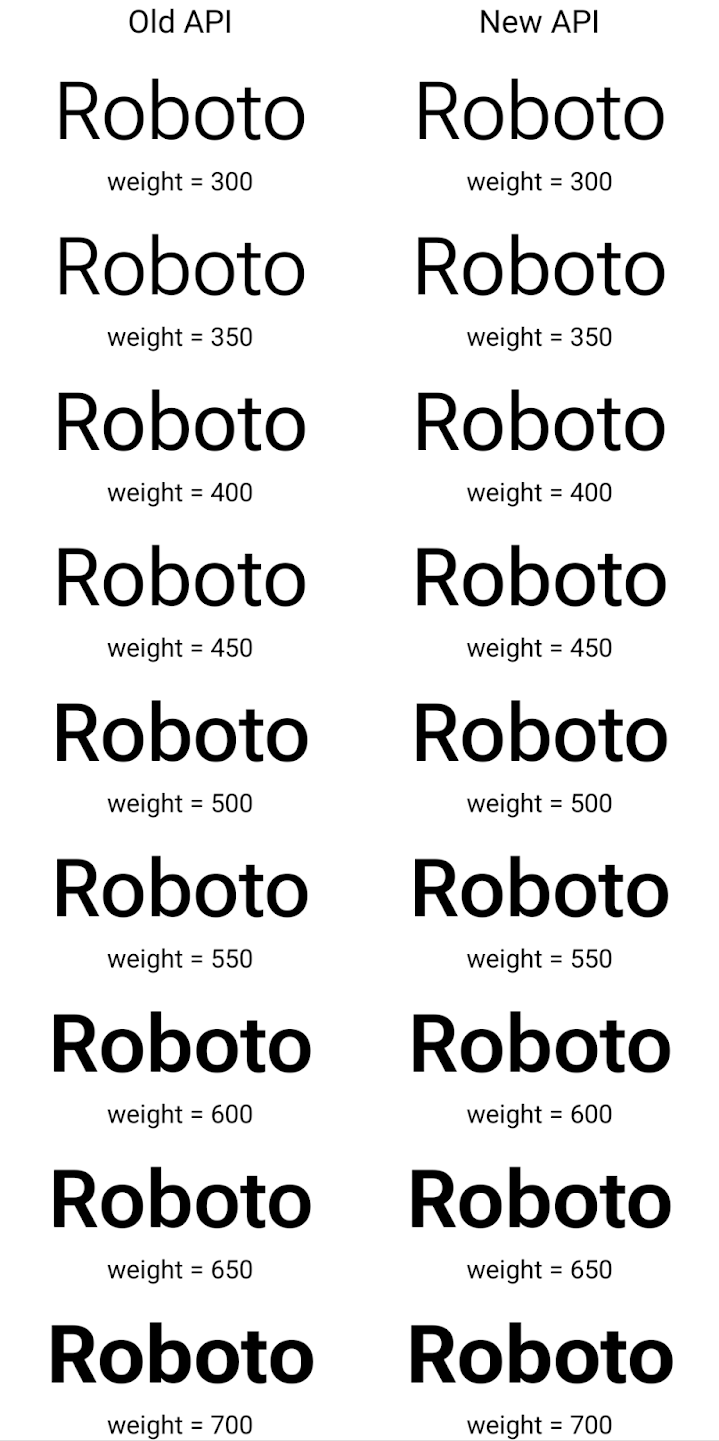
In this example, the Typeface created with the old API doesn't have the
capability to create accurate font weights for the 350, 450, 550 and 650
Font instances, so the renderer falls back to the closest weight. So in
this case, 300 is rendered instead of 350, 400 is rendered instead of 450, and
so on. By contrast, the Typeface created with the new APIs dynamically creates
a Font instance for a given weight, so accurate weights are rendered for 350,
450, 550, and 650 as well.
Детальное управление разрывами строк
Начиная с Android 15, TextView и базовый разрыв строки могут сохранять заданную часть текста в одной строке для улучшения читаемости. Вы можете воспользоваться преимуществами этой настройки разрыва строки, используя тег <nobreak> в строковых ресурсах или createNoBreakSpan . Аналогичным образом вы можете предотвратить расстановку переносов в словах, используя тег <nohyphen> или createNoHyphenationSpan .
Например, следующий строковый ресурс не содержит разрыва строки и отображается с текстом «Pixel 8 Pro». поломка в нежелательном месте:
<resources>
<string name="pixel8pro">The power and brains behind Pixel 8 Pro.</string>
</resources>
Напротив, этот строковый ресурс включает тег <nobreak> , который окружает фразу «Pixel 8 Pro». и предотвращает разрывы строк:
<resources>
<string name="pixel8pro">The power and brains behind <nobreak>Pixel 8 Pro.</nobreak></string>
</resources>
Разница в том, как отображаются эти строки, показана на следующих изображениях:
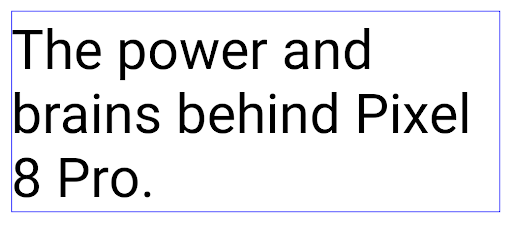
<nobreak> . 
<nobreak> .Архивация приложений
Android and Google Play announced support for app archiving last year, allowing users to free up space by partially removing infrequently used apps from the device that were published using Android App Bundle on Google Play. Android 15 includes OS level support for app archiving and unarchiving, making it easier for all app stores to implement it.
Apps with the REQUEST_DELETE_PACKAGES permission can call the
PackageInstaller requestArchive method to request archiving an
installed app package, which removes the APK and any cached files, but persists
user data. Archived apps are returned as displayable apps through the
LauncherApps APIs; users will see a UI treatment to highlight that those
apps are archived. If a user taps on an archived app, the responsible installer
will get a request to unarchive it, and the restoration process can be
monitored by the ACTION_PACKAGE_ADDED broadcast.
Включите режим 16 КБ на устройстве с помощью параметров разработчика
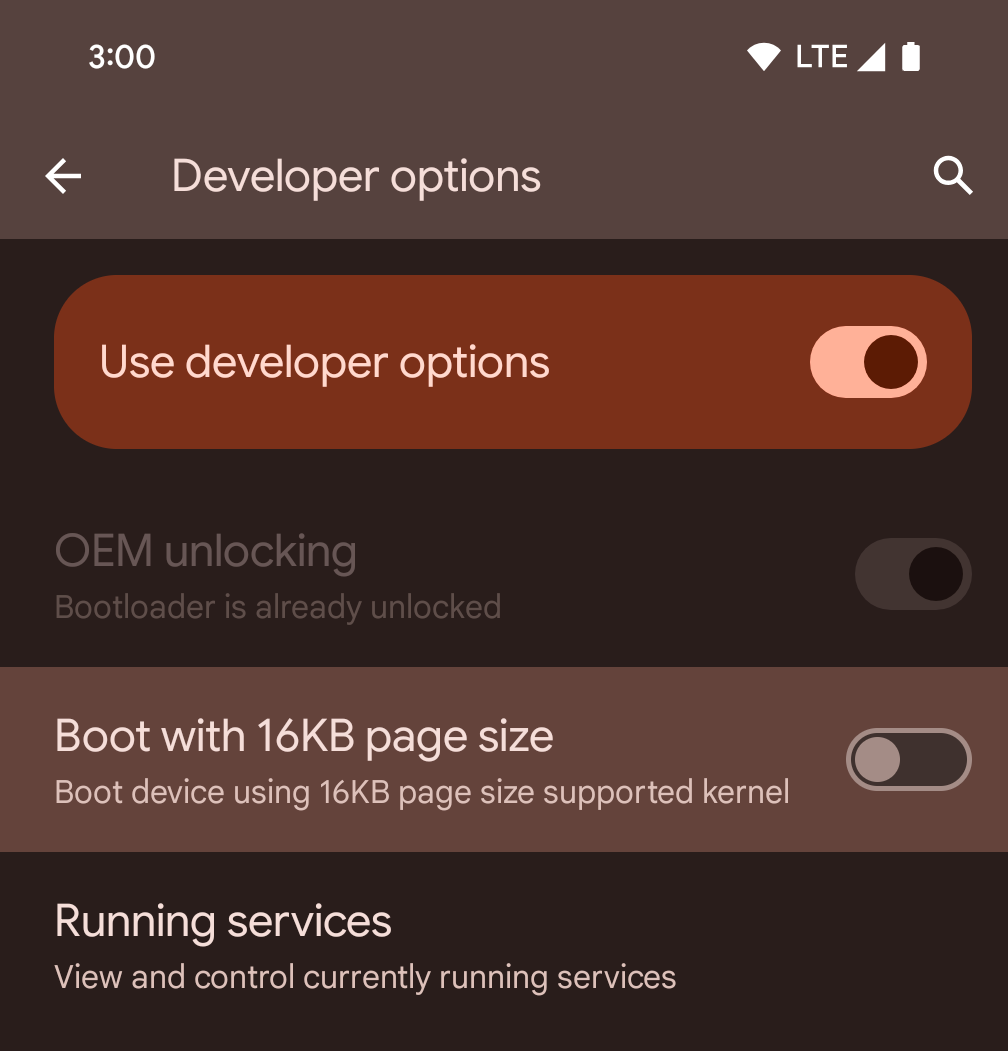
Включите опцию разработчика «Загрузка с размером страницы 16 КБ», чтобы загрузить устройство в режиме 16 КБ.
В версиях Android 15 для QPR вы можете использовать функцию разработчика , доступную на некоторых устройствах, для загрузки устройства в режиме 16 КБ и проведения тестирования на устройстве. Перед использованием функции разработчика перейдите в раздел «Настройки» > «Система» > «Обновления ПО» и установите все доступные обновления.
Эта опция разработчика доступна на следующих устройствах:
Pixel 8 и 8 Pro (с Android 15 QPR1 или выше)
Pixel 8a (с Android 15 QPR1 или выше)
Pixel 9, 9 Pro и 9 Pro XL (с Android 15 QPR2 Beta 2 или выше)
Графика
Android 15 предлагает новейшие графические улучшения, включая ANGLE и дополнения к графической системе Canvas.
Модернизация доступа к графическому процессору Android

Android hardware has evolved quite a bit from the early days where the core OS would run on a single CPU and GPUs were accessed using APIs based on fixed-function pipelines. The Vulkan® graphics API has been available in the NDK since Android 7.0 (API level 24) with a lower-level abstraction that better reflects modern GPU hardware, scales better to support multiple CPU cores, and offers reduced CPU driver overhead — leading to improved app performance. Vulkan is supported by all modern game engines.
Vulkan is Android's preferred interface to the GPU. Therefore, Android 15 includes ANGLE as an optional layer for running OpenGL® ES on top of Vulkan. Moving to ANGLE will standardize the Android OpenGL implementation for improved compatibility, and, in some cases, improved performance. You can test out your OpenGL ES app stability and performance with ANGLE by enabling the developer option in Settings -> System -> Developer Options -> Experimental: Enable ANGLE on Android 15.
The Android ANGLE on Vulkan roadmap

As part of streamlining our GPU stack, going forward we will be shipping ANGLE as the GL system driver on more new devices, with the future expectation that OpenGL/ES will be only available through ANGLE. That being said, we plan to continue support for OpenGL ES on all devices.
Recommended next steps
Use the developer options to select the ANGLE driver for OpenGL ES and test your app. For new projects, we strongly encourage using Vulkan for C/C++.
Улучшения для Canvas
Android 15 continues our modernization of Android's Canvas graphics system with additional capabilities:
Matrix44provides a 4x4 matrix for transforming coordinates that should be used when you want to manipulate the canvas in 3D.clipShaderintersects the current clip with the specified shader, whileclipOutShadersets the clip to the difference of the current clip and the shader, each treating the shader as an alpha mask. This supports the drawing of complex shapes efficiently.
Производительность и аккумулятор
Android продолжает помогать вам повышать производительность и качество ваших приложений. В Android 15 представлены API, которые помогают повысить эффективность выполнения задач в вашем приложении, оптимизировать производительность приложений и собирать аналитическую информацию о них.
Чтобы ознакомиться с лучшими практиками экономии заряда батареи, отладкой сети и энергопотребления, а также узнать подробности о том, как мы повышаем эффективность использования батареи при фоновой работе в Android 15 и последних версиях Android, ознакомьтесь с докладом « Повышение эффективности использования батареи при фоновой работе в Android» на конференции Google I/O.
API ApplicationStartInfo
In previous versions of Android, app startup has been a bit of a mystery. It was
challenging to determine within your app whether it started from a cold, warm,
or hot state. It was also difficult to know how long your app spent during the
various launch phases: forking the process, calling onCreate, drawing the
first frame, and more. When your Application class was instantiated, you had no
way of knowing whether the app started from a broadcast, a content provider, a
job, a backup, boot complete, an alarm, or an Activity.
The ApplicationStartInfo API on Android 15 provides
all of this and more. You can even choose to add your own timestamps into the
flow to help collect timing data in one place. In addition to collecting
metrics, you can use ApplicationStartInfo to help directly optimize app
startup; for example, you can eliminate the costly instantiation of UI-related
libraries within your Application class when your app is starting up due to a
broadcast.
Подробная информация о размере приложения
Since Android 8.0 (API level 26), Android has included the
StorageStats.getAppBytes API that summarizes the installed
size of an app as a single number of bytes, which is a sum of the APK size, the
size of files extracted from the APK, and files that were generated on the
device such as ahead-of-time (AOT) compiled code. This number is not very
insightful in terms of how your app is using storage.
Android 15 adds the
StorageStats.getAppBytesByDataType([type]) API, which lets
you get insight into how your app is using up all that space, including APK file
splits, AOT and speedup related code, dex metadata, libraries, and guided
profiles.
Профилирование, управляемое приложением
Android 15 includes the ProfilingManager class,
which lets you collect profiling information from within your app such as heap
dumps, heap profiles, stack sampling, and more. It provides a callback to your
app with a supplied tag to identify the output file, which is delivered to your
app's files directory. The API does rate limiting to minimize the performance
impact.
To simplify constructing profiling requests in your app, we recommend using the
corresponding Profiling AndroidX API, available
in Core 1.15.0-rc01 or higher.
Улучшения базы данных SQLite
Android 15 introduces SQLite APIs that expose advanced features from the underlying SQLite engine that target specific performance issues that can manifest in apps. These APIs are included with the update of SQLite to version 3.44.3.
Developers should consult best practices for SQLite performance to get the most out of their SQLite database, especially when working with large databases or when running latency-sensitive queries.
- Read-only deferred transactions: when issuing transactions that are
read-only (don't include write statements), use
beginTransactionReadOnly()andbeginTransactionWithListenerReadOnly(SQLiteTransactionListener)to issue read-onlyDEFERREDtransactions. Such transactions can run concurrently with each other, and if the database is in WAL mode, they can run concurrently withIMMEDIATEorEXCLUSIVEtransactions. - Row counts and IDs: APIs were added to retrieve the count of changed
rows or the last inserted row ID without issuing an additional query.
getLastChangedRowCount()returns the number of rows that were inserted, updated, or deleted by the most recent SQL statement within the current transaction, whilegetTotalChangedRowCount()returns the count on the current connection.getLastInsertRowId()returns therowidof the last row to be inserted on the current connection. - Raw statements: issue a raw SQlite statement, bypassing convenience wrappers and any additional processing overhead that they may incur.
Обновления Android Dynamic Performance Framework
Android 15 continues our investment in the Android Dynamic Performance Framework (ADPF), a set of APIs that allow games and performance intensive apps to interact more directly with power and thermal systems of Android devices. On supported devices, Android 15 adds ADPF capabilities:
- A power-efficiency mode for hint sessions to indicate that their associated threads should prefer power saving over performance, great for long-running background workloads.
- GPU and CPU work durations can both be reported in hint sessions, allowing the system to adjust CPU and GPU frequencies together to best meet workload demands.
- Thermal headroom thresholds to interpret possible thermal throttling status based on headroom prediction.
To learn more about how to use ADPF in your apps and games, head over to the documentation.
Конфиденциальность
Android 15 включает в себя ряд функций, которые помогают разработчикам приложений защищать конфиденциальность пользователей.
Обнаружение записи экрана
Android 15 adds support for apps to detect that they are being recorded. A callback is invoked whenever the app transitions between being visible or invisible within a screen recording. An app is considered visible if activities owned by the registering process's UID are being recorded. This way, if your app is performing a sensitive operation, you can inform the user that they're being recorded.
val mCallback = Consumer<Int> { state ->
if (state == SCREEN_RECORDING_STATE_VISIBLE) {
// We're being recorded
} else {
// We're not being recorded
}
}
override fun onStart() {
super.onStart()
val initialState =
windowManager.addScreenRecordingCallback(mainExecutor, mCallback)
mCallback.accept(initialState)
}
override fun onStop() {
super.onStop()
windowManager.removeScreenRecordingCallback(mCallback)
}
Расширенные возможности IntentFilter
В Android 15 реализована поддержка более точного разрешения Intent с помощью UriRelativeFilterGroup , который содержит набор объектов UriRelativeFilter , формирующих набор правил сопоставления Intent , каждое из которых должно выполняться, включая параметры URL-запроса, фрагменты URL-адресов и правила блокировки или исключения.
Эти правила можно определить в XML-файле AndroidManifest с помощью тега <uri-relative-filter-group> , который при необходимости может включать тег android:allow . Эти теги могут содержать теги <data> , которые используют существующие атрибуты тегов данных, а также атрибуты android:query и android:fragment .
Вот пример синтаксиса AndroidManifest :
<intent-filter android:autoVerify="true">
<action android:name="android.intent.action.VIEW" />
<category android:name="android.intent.category.BROWSABLE" />
<category android:name="android.intent.category.DEFAULT" />
<data android:scheme="http" />
<data android:scheme="https" />
<data android:host="astore.com" />
<uri-relative-filter-group>
<data android:pathPrefix="/auth" />
<data android:query="region=na" />
</uri-relative-filter-group>
<uri-relative-filter-group android:allow="false">
<data android:pathPrefix="/auth" />
<data android:query="mobileoptout=true" />
</uri-relative-filter-group>
<uri-relative-filter-group android:allow="false">
<data android:pathPrefix="/auth" />
<data android:fragmentPrefix="faq" />
</uri-relative-filter-group>
</intent-filter>
Личное пространство
Private space lets users create a separate space on their device where they can keep sensitive apps away from prying eyes, under an additional layer of authentication. The private space uses a separate user profile. The user can choose to use the device lock or a separate lock factor for the private space.
Apps in the private space show up in a separate container in the launcher, and are hidden from the recents view, notifications, settings, and from other apps when the private space is locked. User-generated and downloaded content (such as media or files) and accounts are separated between the private space and the main space. The system sharesheet and the photo picker can be used to give apps access to content across spaces when the private space is unlocked.
Users can't move existing apps and their data into the private space. Instead, users select an install option in the private space to install an app using whichever app store they prefer. Apps in the private space are installed as separate copies from any apps in the main space (new copies of the same app).
When a user locks the private space, the profile is stopped. While the profile is stopped, apps in the private space are no longer active and can't perform foreground or background activities, including showing notifications.
We recommend that you test your app with private space to make sure your app works as expected, especially if your app falls into one of the following categories:
- Apps with logic for work profiles that assumes that any installed copies of their app that aren't in the main profile are in the work profile.
- Medical apps
- Launcher apps
- App store apps
Запрос последнего выбора пользователя для доступа к выбранным фотографиям
Приложения теперь могут выделять только те фотографии и видео, которые были выбраны последними, если предоставлен частичный доступ к медиа-разрешениям. Эта функция может улучшить взаимодействие с пользователем в приложениях, которые часто запрашивают доступ к фотографиям и видео. Чтобы использовать эту функцию в своем приложении, включите аргумент QUERY_ARG_LATEST_SELECTION_ONLY при запросе MediaStore через ContentResolver .
Котлин
val externalContentUri = MediaStore.Files.getContentUri("external") val mediaColumns = arrayOf( FileColumns._ID, FileColumns.DISPLAY_NAME, FileColumns.MIME_TYPE, ) val queryArgs = bundleOf( // Return only items from the last selection (selected photos access) QUERY_ARG_LATEST_SELECTION_ONLY to true, // Sort returned items chronologically based on when they were added to the device's storage QUERY_ARG_SQL_SORT_ORDER to "${FileColumns.DATE_ADDED} DESC", QUERY_ARG_SQL_SELECTION to "${FileColumns.MEDIA_TYPE} = ? OR ${FileColumns.MEDIA_TYPE} = ?", QUERY_ARG_SQL_SELECTION_ARGS to arrayOf( FileColumns.MEDIA_TYPE_IMAGE.toString(), FileColumns.MEDIA_TYPE_VIDEO.toString() ) )
Ява
Uri externalContentUri = MediaStore.Files.getContentUri("external"); String[] mediaColumns = { FileColumns._ID, FileColumns.DISPLAY_NAME, FileColumns.MIME_TYPE }; Bundle queryArgs = new Bundle(); queryArgs.putBoolean(MediaStore.QUERY_ARG_LATEST_SELECTION_ONLY, true); queryArgs.putString(MediaStore.QUERY_ARG_SQL_SORT_ORDER, FileColumns.DATE_ADDED + " DESC"); queryArgs.putString(MediaStore.QUERY_ARG_SQL_SELECTION, FileColumns.MEDIA_TYPE + " = ? OR " + FileColumns.MEDIA_TYPE + " = ?"); queryArgs.putStringArray(MediaStore.QUERY_ARG_SQL_SELECTION_ARGS, new String[] { String.valueOf(FileColumns.MEDIA_TYPE_IMAGE), String.valueOf(FileColumns.MEDIA_TYPE_VIDEO) });
Privacy Sandbox на Android
Android 15 включает новейшие расширения Android Ad Services, включая последнюю версию Privacy Sandbox для Android . Это дополнение является частью нашей работы по разработке технологий, которые улучшают конфиденциальность пользователей и обеспечивают эффективную персонализированную рекламу для мобильных приложений. На нашей странице «Песочница конфиденциальности» вы найдете дополнительную информацию о предварительной версии и бета-версиях Privacy Sandbox для разработчиков Android, которые помогут вам начать работу.
Health Connect
Android 15 объединяет новейшие расширения Health Connect от Android — безопасной и централизованной платформы для управления и обмена данными о здоровье и фитнесе, собранными приложениями. В этом обновлении добавлена поддержка дополнительных типов данных о фитнесе , питании , температуре кожи, планах тренировок и многом другом.
Отслеживание температуры кожи позволяет пользователям хранить и передавать более точные данные о температуре с носимого или другого устройства отслеживания.
Планы тренировок — это структурированные планы тренировок, которые помогают пользователю достичь своих целей в фитнесе. Поддержка планов обучения включает в себя различные цели завершения и производительности:
- Цели достижения, касающиеся сожженных калорий , расстояния , продолжительности , повторений и шагов .
- Цели производительности включают максимально возможное количество повторений (AMRAP) , частоту шагов , частоту сердечных сокращений , мощность , воспринимаемую скорость нагрузки и скорость .
Узнайте больше о последних обновлениях Health Connect в Android в докладе «Создание адаптируемого опыта с помощью Android Health» от Google I/O.
,Android 15 объединяет новейшие расширения Health Connect от Android — безопасной и централизованной платформы для управления и обмена данными о здоровье и фитнесе, собранными приложениями. В этом обновлении добавлена поддержка дополнительных типов данных о фитнесе , питании , температуре кожи, планах тренировок и многом другом.
Отслеживание температуры кожи позволяет пользователям хранить и передавать более точные данные о температуре с носимого или другого устройства слежения.
Планы тренировок — это структурированные планы тренировок, которые помогают пользователю достичь своих целей в фитнесе. Поддержка планов обучения включает в себя различные цели завершения и производительности:
- Цели достижения, касающиеся сожженных калорий , расстояния , продолжительности , повторений и шагов .
- Цели производительности включают максимально возможное количество повторений (AMRAP) , частоту шагов , частоту сердечных сокращений , мощность , воспринимаемую скорость нагрузки и скорость .
Узнайте больше о последних обновлениях Health Connect в Android в докладе «Создание адаптируемого опыта с помощью Android Health» от Google I/O.
Совместное использование экрана приложения
Android 15 supports app screen sharing so users can share or record just an
app window rather than the entire device screen. This feature, first enabled in
Android 14 QPR2, includes
MediaProjection callbacks that allow your app
to customize the app screen sharing experience. Note that for apps targeting
Android 14 (API level 34) or higher,
user consent is required for each
MediaProjection capture session.
Пользовательский опыт и системный пользовательский интерфейс
Android 15 предоставляет разработчикам приложений и пользователям больше возможностей и гибкости для настройки устройств в соответствии со своими потребностями.
Чтобы узнать больше о том, как использовать последние улучшения в Android 15 для улучшения пользовательского опыта вашего приложения, ознакомьтесь с докладом « Улучшение пользовательского опыта вашего приложения для Android» на конференции Google I/O.
Более подробные предварительные просмотры виджетов с помощью API Generated Previews
Before Android 15, the only way to provide widget picker previews was to specify a static image or layout resource. These previews often differ significantly from the look of the actual widget when it is placed on the home screen. Also, static resources can't be created with Jetpack Glance, so a Glance developer had to screenshot their widget or create an XML layout to have a widget preview.
Android 15 adds support for generated previews. This means that app widget
providers can generate RemoteViews to use as the picker preview, instead
of a static resource.

Push API
Apps can provide generated previews through a push API. Apps can provide
previews at any point in their lifecycle, and don't receive an explicit request
from the host to provide previews. Previews are persisted in AppWidgetService,
and hosts can request them on-demand. The following example loads an XML widget
layout resource and sets it as the preview:
AppWidgetManager.getInstance(appContext).setWidgetPreview(
ComponentName(
appContext,
SociaLiteAppWidgetReceiver::class.java
),
AppWidgetProviderInfo.WIDGET_CATEGORY_HOME_SCREEN,
RemoteViews("com.example", R.layout.widget_preview)
)
The expected flow is:
- At any time, the widget provider calls
setWidgetPreview. The provided previews are persisted inAppWidgetServicewith other provider info. setWidgetPreviewnotifies hosts of an updated preview through theAppWidgetHost.onProvidersChangedcallback. In response, the widget host reloads all of its provider information.- When displaying a widget preview, the host checks
AppWidgetProviderInfo.generatedPreviewCategories, and if the chosen category is available, callsAppWidgetManager.getWidgetPreviewto return the saved preview for this provider.
When to call setWidgetPreview
Because there is no callback to provide previews, apps can choose to send previews at any point when they are running. How often to update the preview depends on the widget's use case.
The following list describes the two main categories of preview use cases:
- Providers that show real data in their widget previews, such as personalized or recent information. These providers can set the preview once the user has signed in or has done initial configuration in their app. After this, they can set up a periodic task to update the previews at their chosen cadence. Examples of this type of widget could be a photo, calendar, weather or news widget.
- Providers that show static information in previews or quick-action widgets that don't display any data. These providers can set previews once, when the app first launches. Examples of this type of widget include a drive quick actions widget or chrome shortcuts widget.
Some providers might show static previews on the hub mode picker, but real information on the homescreen picker. These providers should follow the guidance for both of these use cases to set previews.
Картинка в картинке
В Android 15 представлены изменения в режиме «картинка в картинке» (PiP), обеспечивающие еще более плавный переход при входе в режим «картинка в картинке». Это будет полезно для приложений, в которых элементы пользовательского интерфейса накладываются поверх основного пользовательского интерфейса, который входит в PiP.
Разработчики используют обратный вызов onPictureInPictureModeChanged для определения логики, которая переключает видимость наложенных элементов пользовательского интерфейса. Этот обратный вызов запускается, когда завершается анимация входа или выхода PiP. Начиная с Android 15, класс PictureInPictureUiState включает еще одно состояние.
В этом состоянии пользовательского интерфейса приложения, предназначенные для Android 15 (уровень API 35), будут наблюдать за вызовом обратного вызова Activity#onPictureInPictureUiStateChanged с помощью isTransitioningToPip() как только начнется анимация PiP. Существует множество элементов пользовательского интерфейса, которые не имеют отношения к приложению, когда оно находится в режиме «картинка в картинке», например представления или макет, включающие такую информацию, как предложения, предстоящие видео, рейтинги и заголовки. Когда приложение переходит в режим PiP, используйте обратный вызов onPictureInPictureUiStateChanged , чтобы скрыть эти элементы пользовательского интерфейса. Когда приложение переходит в полноэкранный режим из окна PiP, используйте обратный вызов onPictureInPictureModeChanged чтобы отобразить эти элементы, как показано в следующих примерах:
override fun onPictureInPictureUiStateChanged(pipState: PictureInPictureUiState) {
if (pipState.isTransitioningToPip()) {
// Hide UI elements
}
}
override fun onPictureInPictureModeChanged(isInPictureInPictureMode: Boolean) {
if (isInPictureInPictureMode) {
// Unhide UI elements
}
}
Это быстрое переключение видимости ненужных элементов пользовательского интерфейса (для окна PiP) помогает обеспечить более плавную анимацию входа в PiP без мерцания.
Улучшенные правила «Не беспокоить»
AutomaticZenRule позволяет приложениям настраивать правила управления вниманием (не беспокоить) и решать, когда их активировать или деактивировать. В Android 15 эти правила значительно усовершенствованы с целью улучшения пользовательского опыта. Включены следующие улучшения:
- Добавление типов в
AutomaticZenRule, позволяющее системе применять специальную обработку к некоторым правилам. - Добавление значка в
AutomaticZenRule, помогающее сделать режимы более узнаваемыми. - Добавление в
AutomaticZenRuleстрокиtriggerDescription, описывающей условия, при которых правило должно стать активным для пользователя. - В
AutomaticZenRuleдобавленZenDeviceEffects, позволяющий правилам запускать такие функции, как отображение оттенков серого, ночной режим или затемнение обоев.
Установить VibrationEffect для каналов уведомлений
Android 15 поддерживает настройку насыщенной вибрации для входящих уведомлений по каналам с помощью NotificationChannel.setVibrationEffect , поэтому ваши пользователи могут различать разные типы уведомлений, не глядя на свое устройство.
Чип строки состояния проекции мультимедиа и автоматическая остановка
Медиа-проекция может раскрыть личную информацию пользователя. Новый, заметный чип строки состояния информирует пользователей о любой текущей проекции экрана. Пользователи могут коснуться чипа, чтобы остановить трансляцию экрана, совместное использование или запись. Кроме того, для более интуитивно понятного взаимодействия с пользователем любое текущее проецирование экрана теперь автоматически останавливается при блокировке экрана устройства.

Большие экраны и форм-факторы
Android 15 позволяет вашим приложениям максимально эффективно использовать все возможности форм-факторов Android, включая большие экраны, переворачивающиеся и складные устройства.
Улучшенная многозадачность на большом экране
Android 15 gives users better ways to multitask on large screen devices. For example, users can save their favorite split-screen app combinations for quick access and pin the taskbar on screen to quickly switch between apps. This means that making sure your app is adaptive is more important than ever.
Google I/O has sessions on Building adaptive Android apps and Building UI with the Material 3 adaptive library that can help, and our documentation has more to help you Design for large screens.
Поддержка защитного экрана
Ваше приложение может объявить свойство , которое Android 15 использует, чтобы позволить вашему Application или Activity отображаться на небольших верхних экранах поддерживаемых переворачивающихся устройств. Эти экраны слишком малы, чтобы их можно было рассматривать как совместимые цели для запуска приложений Android, но ваше приложение может согласиться на их поддержку, что сделает ваше приложение доступным в большем количестве мест.
Связность
Android 15 обновляет платформу, предоставляя вашему приложению доступ к новейшим достижениям в области коммуникационных и беспроводных технологий.
Спутниковая поддержка
Android 15 continues to extend platform support for satellite connectivity and includes some UI elements to ensure a consistent user experience across the satellite connectivity landscape.
Apps can use ServiceState.isUsingNonTerrestrialNetwork() to
detect when a device is connected to a satellite, giving them more awareness of
why full network services might be unavailable. Additionally, Android 15
provides support for SMS and MMS apps as well as preloaded RCS apps to use
satellite connectivity for sending and receiving messages.
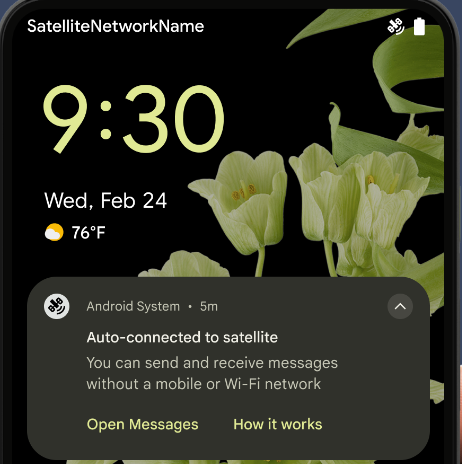
Более плавный опыт использования NFC
Android 15 is working to make the tap to pay experience more seamless and
reliable while continuing to support Android's robust NFC app ecosystem. On
supported devices, apps can request the NfcAdapter to enter
observe mode, where the device listens but doesn't respond to NFC
readers, sending the app's NFC service PollingFrame
objects to process. The PollingFrame objects can be used to auth
ahead of the first communication to the NFC reader, allowing for a one tap
transaction in many cases.
In addition, apps can register a filter on supported devices so they can be notified of polling loop activity, which allows for smooth operation with multiple NFC-aware applications.
Роль кошелька
Android 15 introduces a Wallet role that allows tighter integration with the user's preferred wallet app. This role replaces the NFC default contactless payment setting. Users can manage the Wallet role holder by navigating to Settings > Apps > Default Apps.
The Wallet role is used when routing NFC taps for AIDs registered in the payment category. Taps always go to the Wallet role holder unless another app that is registered for the same AID is running in the foreground.
This role is also used to determine where the Wallet Quick Access tile should go when activated. When the role is set to "None", the Quick Access tile isn't available and payment category NFC taps are only delivered to the foreground app.
Безопасность
Android 15 помогает повысить безопасность вашего приложения, защитить его данные и предоставляет пользователям больше прозрачности и контроля над своими данными. Подробнее о наших действиях по улучшению защиты пользователей и защите вашего приложения от новых угроз читайте в докладе « Защита безопасности пользователей Android» на конференции Google I/O.
Интеграция Credential Manager с функцией автозаполнения
Starting with Android 15, developers can link specific views like username or password fields with Credential Manager requests, making it easier to provide a tailored user experience during the sign-in process. When the user focuses on one of these views, a corresponding request is sent to Credential Manager. The resulting credentials are aggregated across providers and displayed in autofill fallback UIs, such as inline suggestions or drop-down suggestions. The Jetpack androidx.credentials library is the preferred endpoint for developers to use and will soon be available to further enhance this feature in Android 15 and higher.
Интеграция регистрации и входа в систему одним нажатием с биометрическими подсказками
Credential Manager integrates biometric prompts into the credential creation and sign-in processes, eliminating the need for providers to manage biometric prompts. As a result, credential providers only need to focus on the results of the create and get flows, augmented with the biometric flow result. This simplified process creates a more efficient and streamlined credential creation and retrieval process.
Управление ключами для сквозного шифрования
Мы представляем E2eeContactKeysManager в Android 15, который упрощает сквозное шифрование (E2EE) в ваших приложениях Android, предоставляя API на уровне ОС для хранения криптографических открытых ключей.
E2eeContactKeysManager предназначен для интеграции с приложением контактов платформы, чтобы предоставить пользователям централизованный способ управления и проверки открытых ключей своих контактов.
Проверка разрешений на URI контента
Android 15 introduces a set of APIs that perform permission checks on content URIs:
Context.checkContentUriPermissionFull: This performs a full permission check on content URIs.Activitymanifest attributerequireContentUriPermissionFromCaller: This enforces specified permissions on the provided content URIs at activity launch.ComponentCallerclass forActivitycallers: This represents the app that launched the activity.
Доступность
В Android 15 добавлены функции, улучшающие доступность для пользователей.
Лучший шрифт Брайля
В Android 15 мы позволили TalkBack поддерживать дисплеи Брайля, использующие стандарт HID, как через USB, так и через защищенный Bluetooth.
Этот стандарт, очень похожий на тот, который используется в мышах и клавиатурах, со временем поможет Android поддерживать более широкий спектр дисплеев Брайля.
Интернационализация
В Android 15 добавлены функции и возможности, которые дополняют пользовательский опыт при использовании устройства на разных языках.
Переменный шрифт CJK
Starting with Android 15, the font file for Chinese, Japanese, and Korean (CJK) languages, NotoSansCJK, is now a variable font. Variable fonts open up possibilities for creative typography in CJK languages. Designers can explore a broader range of styles and create visually striking layouts that were previously difficult or impossible to achieve.
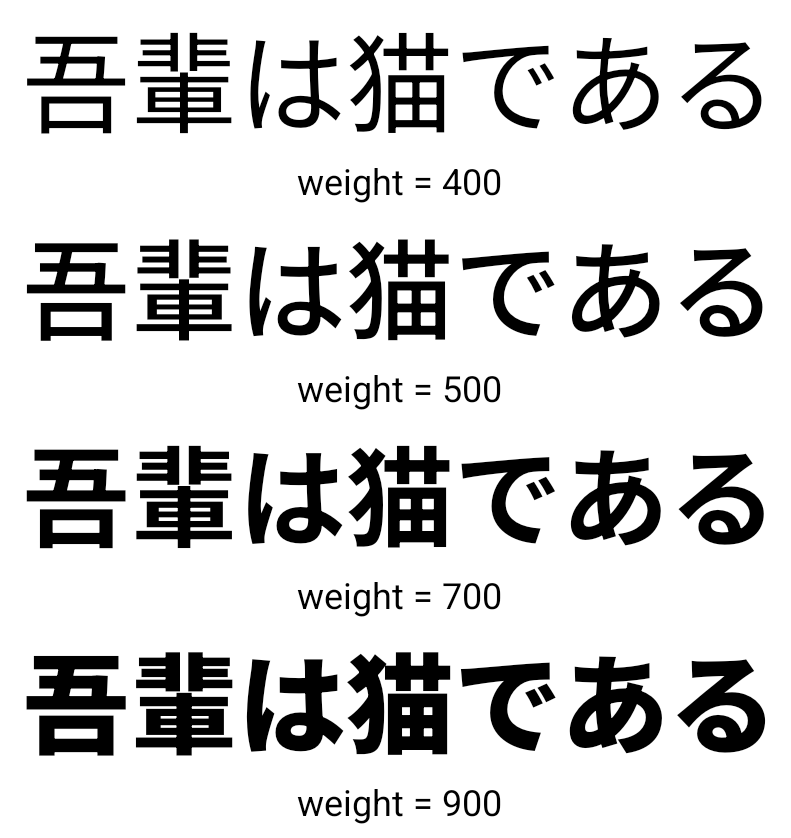
Межсимвольное выравнивание
Starting with Android 15, text can be justified utilizing letter spacing by
using JUSTIFICATION_MODE_INTER_CHARACTER. Inter-word justification was
first introduced in Android 8.0 (API level 26), and inter-character
justification provides similar capabilities for languages that use the
whitespace character for segmentation, such as Chinese, Japanese, and others.

JUSTIFICATION_MODE_NONE.
JUSTIFICATION_MODE_NONE.
JUSTIFICATION_MODE_INTER_WORD.
JUSTIFICATION_MODE_INTER_WORD.
JUSTIFICATION_MODE_INTER_CHARACTER.
JUSTIFICATION_MODE_INTER_CHARACTER.Автоматическая настройка разрыва строки
Android started supporting phrase-based line breaks for Japanese and Korean in
Android 13 (API level 33). However, while phrase-based line breaks improve the
readability of short lines of text, they don't work well for long lines of text.
In Android 15, apps can apply phrase-based line breaks only for short lines
of text, using the LINE_BREAK_WORD_STYLE_AUTO
option. This option selects the best word style option for the text.
For short lines of text, phrase-based line breaks are used, functioning the same
as LINE_BREAK_WORD_STYLE_PHRASE, as shown in the
following image:
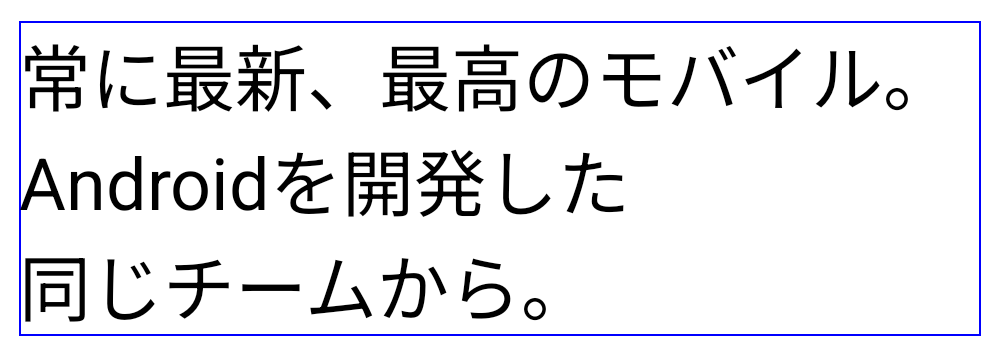
LINE_BREAK_WORD_STYLE_AUTO
applies phrase-based line breaks to improve the readability of the text.
This is the same as applying
LINE_BREAK_WORD_STYLE_PHRASE.For longer lines of text, LINE_BREAK_WORD_STYLE_AUTO uses a no
line-break word style, functioning the same as
LINE_BREAK_WORD_STYLE_NONE, as shown in the
following image:

LINE_BREAK_WORD_STYLE_AUTO
applies no line-break word style to improve the readability of the text.
This is the same as applying
LINE_BREAK_WORD_STYLE_NONE.Дополнительный японский шрифт Hentaigana
В Android 15 по умолчанию включен файл шрифта для старой японской хираганы (известной как хентайгана). Уникальные формы символов хентайганы могут придать особый шарм произведениям искусства или дизайну, а также помогают сохранить точную передачу и понимание древних японских документов.
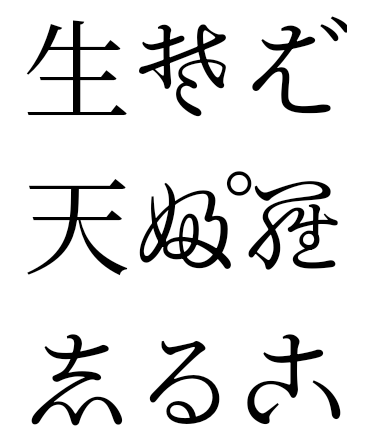
Конус VideoLAN Copyright (c) 1996-2010 VideoLAN. Этот логотип или его измененная версия может использоваться или изменяться кем-либо для ссылки на проект VideoLAN или любой продукт, разработанный командой VideoLAN, но не означает одобрения проекта.
Vulkan и логотип Vulkan являются зарегистрированными торговыми марками Khronos Group Inc.
OpenGL является зарегистрированной торговой маркой, а логотип OpenGL ES является торговой маркой Hewlett Packard Enterprise, используемой с разрешения Khronos.

